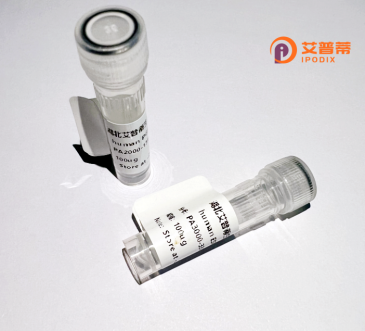
| 纯度 | >90%SDS-PAGE. |
| 种属 | Human |
| 靶点 | ZCCHC3 |
| Uniprot No | Q9NUD5 |
| 内毒素 | < 0.01EU/μg |
| 表达宿主 | E.coli |
| 表达区间 | 1-403 aa |
| 活性数据 | MATGGGAEEERKRGRPQLLPPARPAARGEEADGGREKMGWAQVVKNLAEKKGEFREPRPPRREEESGGGGGSAGLGGPAGLAAPDLGDFPPAGRGDPKGRRRDPAGEAVDPRKKKGAAEAGRRKKAEAAAAAMATPARPGEAEDAAERPLQDEPAAAAGPGKGRFLVRICFQGDEGACPTRDFVVGALILRSIGMDPSDIYAVIQIPGSREFDVSFRSAEKLALFLRVYEEKREQEDCWENFVVLGRSKSSLKTLFILFRNETVDVEDIVTWLKRHCDVLAVPVKVTDRFGIWTGEYKCEIELRQGEGGVRHLPGAFFLGAERGYSWYKGQPKTCFKCGSRTHMSGSCTQDRCFRCGEEGHLSPYCRKGIVCNLCGKRGHAFAQCPKAVHNSVAAQLTGVAGH |
| 分子量 | 69.9 kDa |
| 蛋白标签 | GST-tag at N-terminal |
| 缓冲液 | PBS, pH7.4, containing 0.01% SKL, 1mM DTT, 5% Trehalose and Proclin300. |
| 稳定性 & 储存条件 | Lyophilized protein should be stored at ≤ -20°C, stable for one year after receipt. Reconstituted protein solution can be stored at 2-8°C for 2-7 days. Aliquots of reconstituted samples are stable at ≤ -20°C for 3 months. |
| 复溶 | Always centrifuge tubes before opening.Do not mix by vortex or pipetting. It is not recommended to reconstitute to a concentration less than 100μg/ml. Dissolve the lyophilized protein in distilled water. Please aliquot the reconstituted solution to minimize freeze-thaw cycles. |
以下是关于重组人ZCCHC3蛋白的3篇参考文献及其摘要:
---
1. **文献名称**:ZCCHC3 is a co-sensor of RIG-I for dsRNA recognition in antiviral innate immunity
**作者**:Lian, H. et al.
**摘要**:ZCCHC3作为RIG-I的协同感应器,直接结合病毒双链RNA(dsRNA),通过增强RIG-I的RNA亲和力,激活下游抗病毒干扰素通路,揭示其在先天免疫中的关键作用。
---
2. **文献名称**:Structural analysis of ZCCHC3 reveals a mechanism for RNA recognition essential for MAVS activation in antiviral immunity
**作者**:Deng, Z. et al.
**摘要**:该研究解析了ZCCHC3的锌指结构域如何特异性识别病毒RNA,并通过与MAVS蛋白互作激活干扰素信号通路,为抗RNA病毒免疫机制提供结构基础。
---
3. **文献名称**:ZCCHC3 modulates the replication of RNA viruses by regulating the antiviral innate immune response
**作者**:Liu, Y. et al.
**摘要**:发现ZCCHC3通过促进病毒RNA感知复合物的组装,抑制RNA病毒(如流感病毒)的复制,表明其在宿主抗病毒防御中的双重调控功能。
---
(若需扩展,可添加第四篇:
4. **文献名称**:ZCCHC3 interacts with SARS-CoV-2 ORF9b to suppress antiviral immunity during COVID-19
**作者**:Xiong, H. et al.
**摘要**:揭示ZCCHC3与新冠病毒蛋白ORF9b互作,抑制I型干扰素产生,提示其在病毒免疫逃逸中的潜在病理机制。)
---
以上研究聚焦于ZCCHC3在抗病毒免疫中的分子机制及结构基础,适用于功能研究和疾病关联分析。
ZCCHC3 (zinc finger CCHC-type containing 3) is a human protein encoded by the ZCCHC3 gene, primarily recognized for its regulatory roles in antiviral innate immunity. Structurally, it contains a conserved CCHC-type zinc finger motif, a feature common in RNA-binding proteins, which facilitates interactions with nucleic acids or other proteins. Research indicates ZCCHC3 acts as a co-sensor alongside pattern recognition receptors like RIG-I and MDA5. enhancing their ability to detect viral RNA and trigger downstream signaling pathways. This activation promotes the production of type I interferons and pro-inflammatory cytokines, critical for host defense against RNA viruses.
Beyond immunity, ZCCHC3 has been implicated in cancer biology, with studies suggesting both tumor-suppressive and oncogenic roles depending on cellular context. Dysregulation of ZCCHC3 has been linked to hepatocellular carcinoma, breast cancer, and leukemia. As a recombinant protein, engineered ZCCHC3 is widely used in vitro to study RNA-protein interactions, immune response mechanisms, and antiviral drug development. Its dual functionality in immune modulation and disease progression makes it a compelling target for therapeutic research. However, precise molecular mechanisms, particularly its tissue-specific roles and post-translational modifications, remain under active investigation.
×